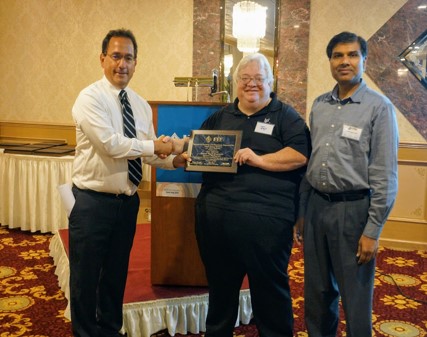Timing and Frequency Distribution using optical fiber
IEEE AP/MTT Mini Show

In RF applications such as radar and electronic warfare, test systems require accurate timing information to be distributed over large campuses or test ranges. This is accomplished through the distribution of 1 pulse per second, IRIG, or 10 MHz references. RF on fiber provides a convenient way to distribute these signals to multiple locations. The optical fiber provides a low-loss transmission medium with no RF interference. Systems have been designed to compensate for any environmental changes in the optical fiber with an accuracy of fewer than 500 ps for distances up to 25 km. These units can be cascaded to provide distributed timing references when GPS is not available. The design of these systems requires careful attention to phase stability and the Allan variance. In this talk, we will review the applications and design of this equipment.
Date and Time
Location
Hosts
Registration
Speakers
George Conway & Jay Darish of Linear Photonics
Timing and Frequency Distribution using optical fiber
In RF applications such as radar and electronic warfare, test systems require accurate timing information to be distributed over large campuses or test ranges. This is accomplished through the distribution of 1 pulse per second, IRIG, or 10 MHz references. RF on fiber provides a convenient way to distribute these signals to multiple locations. The optical fiber provides a low-loss transmission medium with no RF interference.
Systems have been designed to compensate for any environmental changes in the optical fiber with an accuracy of fewer than 500 ps for distances up to 25 km. These units can be cascaded to provide distributed timing references when GPS is not available. The design of these systems requires careful attention to phase stability and the Allan variance. In this talk, we will review the applications and design of this equipment.
Biography:
George Conway has more than 30 years of experience in designing electronic systems and subsystems for such diverse markets as guided missiles, early cellular phone development, television broadcast transmitters, secure have quick radios, and for the last 20 years developing fiber optic systems for commercial and military applications.
Jay Darish has over 25 years of electrical and mechanical engineering design experience for, telecommunications, space, and military environments. He has developed transmitters, receivers, complete systems, and fiber optic packaging for these markets. He is also an adjunct professor with the Engineering Dept. of Bucks Community College. Prior to his employment with Linear Photonics, he was Vice President of Electronics for Radiant Communications Corporation and worked in various design and leadership positions with General Electric, Raytheon, Telco Systems Fiber Optics Corporation, ADC Telecommunications, Hewlett-Packard, and Fiber-Span.
Email:
Address:Linear Photonics, , United States
Agenda
For further information contact:
IEEE NORTH JERSEY SECTION CHAIR & MTT/AP CHAPTER CHAIR – AJAY KUMAR PODDAR (201-560-3806),akpoddar@ieee.org
CHAIR - GENERAL-EXHIBITION: KIRIT DIXIT (201-669-7599), kdixit@ieee.org
CHAIR – TECHNICAL PROGRAMS: GEORGE KANNELL(973-261-1421),george.kannell@gd-ms.com
THERE IS NO CHARGE TO ATTEND THE SYMPOSIUM OR SHOW.


 Add Event to Calendar
Add Event to Calendar